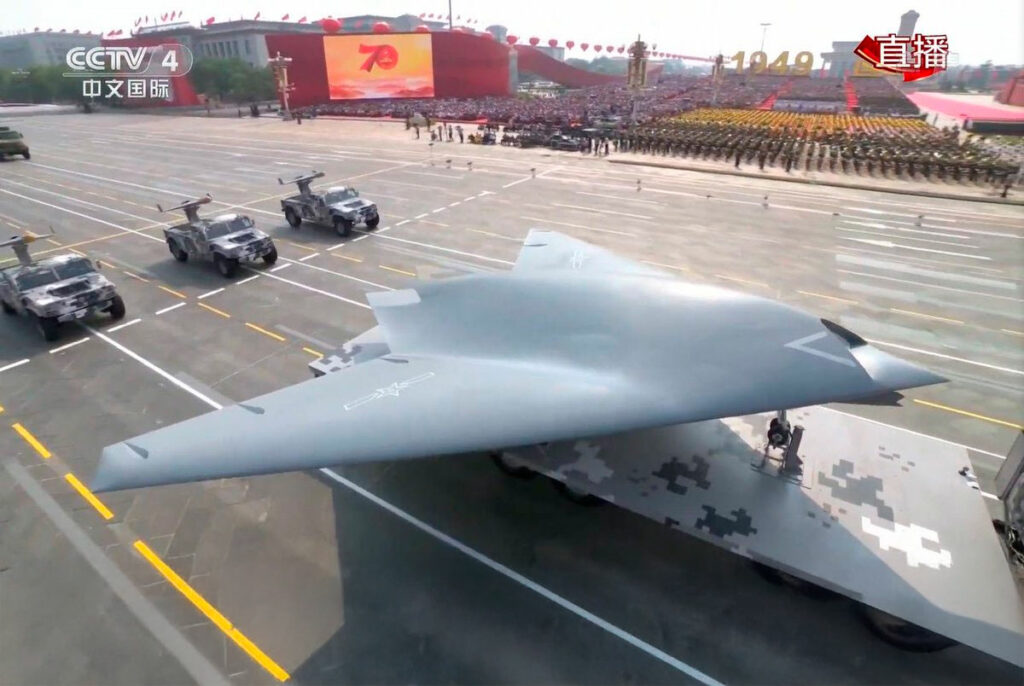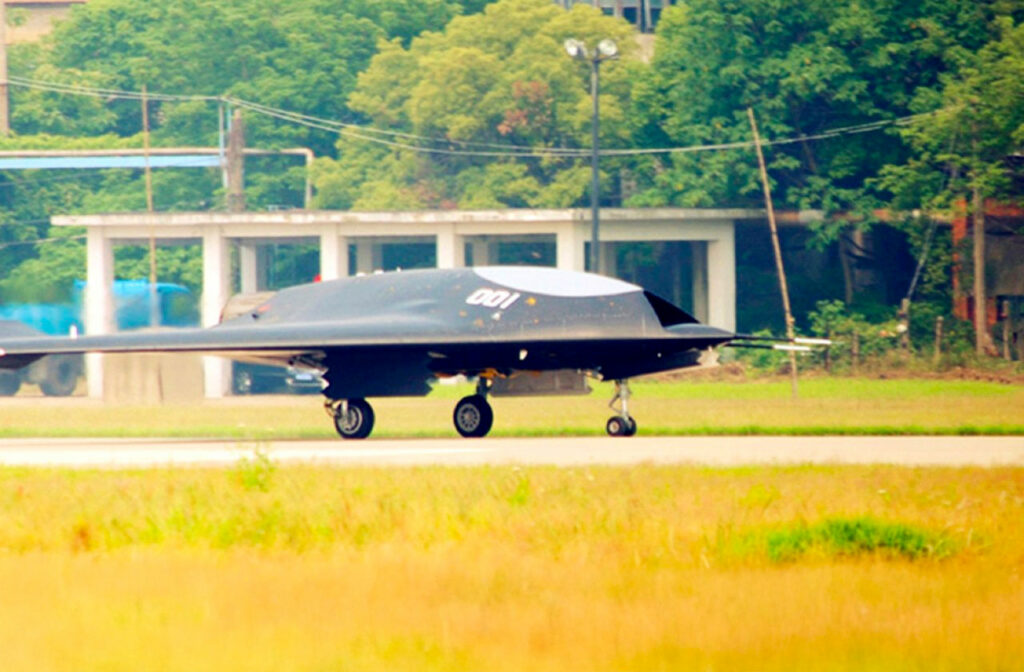The Hongdu Lijian “Sharp Sword” is China’s stealth UCAV featuring a flying wing design, internal weapons bays, and advanced stealth capabilities.
The Hongdu Lijian “Sharp Sword” is a Chinese stealth unmanned combat aerial vehicle (UCAV) developed collaboratively by the Shenyang Aircraft Design Institute (SYADI) and the Hongdu Aviation Industry Group (HAIG). As part of the Aviation Industry Corporation of China’s (AVIC) 601-S program, it represents China’s inaugural foray into jet-powered, stealth UCAVs. The aircraft features a tailless flying wing configuration with a wingspan of approximately 14 meters (45.9 feet). Powered by a single turbofan engine, the Lijian is designed for precision strike and aerial reconnaissance missions. Its stealth characteristics are enhanced by internal weapons bays and carefully contoured airframe surfaces to minimize radar cross-section. The Lijian made its maiden flight on November 21, 2013, marking a significant milestone in China’s unmanned aerial capabilities.
History of the Development of the Hongdu Lijian (Sharp Sword)
In the early 21st century, the global military landscape witnessed a significant shift towards unmanned combat aerial vehicles (UCAVs), emphasizing stealth and precision. Recognizing the strategic advantages of such platforms, China embarked on developing its indigenous stealth UCAV to bolster its defense capabilities and reduce reliance on foreign technology.
The Aviation Industry Corporation of China (AVIC) initiated the 601-S program, aiming to explore advanced unmanned systems. Within this framework, the Shenyang Aircraft Design Institute (SYADI) and the Hongdu Aviation Industry Group (HAIG) collaborated to design and develop the Lijian “Sharp Sword”. The primary objectives were to create a platform capable of precision strikes and aerial reconnaissance while incorporating stealth features to evade advanced air defense systems.
The Lijian’s development phase included extensive design iterations and testing. On November 21, 2013, the prototype undertook its maiden flight, lasting approximately 20 minutes, at the HAIG airfield. This successful flight marked China’s entry into the realm of jet-powered, stealth UCAVs.
Following its initial flight, the Lijian underwent further testing and refinements. Early versions featured an exposed engine nozzle, which was later modified to enhance stealth characteristics. The aircraft’s design evolved to include serrated weapon bay doors and optimized airframe contours to minimize radar cross-section.
In October 2019, during the 70th-anniversary parade of the People’s Republic of China, the Lijian was publicly showcased, indicating its advanced development status and potential induction into the PLA’s operational inventory.
The Lijian’s development reflects China’s strategic intent to advance its indigenous military technology, focusing on unmanned systems that offer both offensive and reconnaissance capabilities. By investing in such platforms, China aims to enhance its strategic autonomy and assert its presence in modern aerial warfare.

Design of the Hongdu Lijian (Sharp Sword)
The Hongdu Lijian “Sharp Sword” exhibits a design that prioritizes stealth, aerodynamic efficiency, and operational versatility. Its structural and aerodynamic features are meticulously crafted to fulfill its roles in precision strike and reconnaissance missions.
Airframe and Dimensions:
- Configuration: Tailless flying wing
- Wingspan: Approximately 14 meters (45.9 feet)
- Length: Approximately 10 meters (32.8 feet)
The flying wing design minimizes radar cross-section by eliminating vertical stabilizers and integrating control surfaces into the wing structure. This configuration reduces aerodynamic drag, enhancing fuel efficiency and endurance.
Stealth Features:
- Internal Weapons Bays: The Lijian houses its armaments within two internal bays, reducing radar reflections that external pylons and weapons would generate.
- Engine Integration: The aircraft is powered by a single turbofan engine, with the air intake positioned atop the fuselage to shield it from ground-based radar. Early prototypes featured exposed engine nozzles, but subsequent designs incorporated stealthier exhaust configurations to minimize infrared and radar signatures.
- Surface Treatments: The airframe’s surfaces are smoothed and coated with radar-absorbent materials, and features like serrated edges on the weapon bay doors further diminish radar visibility.
Landing Gear:
The Lijian is equipped with a tricycle landing gear system, comprising a single nose wheel and two main landing gears. This arrangement supports stability during takeoff and landing operations.
Avionics and Sensors:
While specific details about the Lijian’s avionics suite remain classified, it is anticipated to include advanced systems such as:
- Electro-Optical/Infrared (EO/IR) Sensors: For target acquisition and surveillance
- Synthetic Aperture Radar (SAR): For ground mapping and reconnaissance
- Data Link Systems: Enabling real-time communication with ground control stations
Performance of the Hongdu Lijian (Sharp Sword) Stealth Unmanned Combat Air Vehicle (UCAV)
The Hongdu Lijian, also known as the “Sharp Sword,” is China’s inaugural jet-powered, stealth Unmanned Combat Aerial Vehicle (UCAV). Developed collaboratively by the Hongdu Aviation Industry Group and the Shenyang Aircraft Design Institute, it represents a significant advancement in China’s unmanned aerial capabilities.
Engine and Power
The Lijian is powered by a single turbofan engine. While specific details about the engine model remain undisclosed, it’s believed to be an unnamed Guizhou-built turbofan. This engine choice aligns with China’s emphasis on developing indigenous propulsion systems for its advanced aircraft.
Speed and Altitude
Precise performance metrics for the Lijian are not publicly available. However, given its design and engine configuration, it’s reasonable to infer that the UCAV operates at subsonic speeds, optimized for stealth and endurance rather than high-speed engagements. The operational altitude is also not specified, but similar UCAVs typically operate at medium to high altitudes to balance mission requirements and fuel efficiency.
Range
The exact operational range of the Lijian has not been officially disclosed. However, considering its design and intended roles, it’s plausible that the UCAV has a substantial range, enabling it to conduct extended missions without the need for frequent refueling or recovery.
Payload Capacity
The Lijian features internal weapons bays capable of accommodating up to 2,000 kilograms (approximately 4,400 pounds) of munitions. This design not only enhances its stealth characteristics by reducing radar cross-section but also allows for a versatile array of armaments, including precision-guided bombs and missiles.
Comparative Analysis
When compared to other UCAVs, the Lijian holds its ground as a formidable platform. Its design parallels that of the U.S. Navy’s X-47B, featuring a tailless flying wing configuration that emphasizes stealth. While the X-47B has demonstrated carrier operations, the Lijian’s capabilities in this domain remain speculative. European counterparts like the Dassault nEUROn and BAE Taranis also share similar design philosophies, focusing on low observability and precision strike capabilities. The Lijian’s internal payload capacity is competitive, and its indigenous development showcases China’s growing proficiency in advanced aerospace technologies.

Variants of the Hongdu Lijian (Sharp Sword) Stealth Unmanned Combat Air Vehicle (UCAV)
As of now, the primary known variant of the Lijian is the GJ-11. Unveiled during China’s National Day parade in 2019, the GJ-11 represents an evolution of the original Sharp Sword design. It retains the tailless flying wing configuration but incorporates refinements aimed at enhancing its operational capabilities.
GJ-11 Specifications and Enhancements
The GJ-11 maintains a wingspan of approximately 14.4 meters (47 feet 3 inches) and a length of 12.2 meters (40 feet). Notable design improvements include optimized aerodynamics and potentially upgraded avionics systems. These enhancements are intended to improve the UCAV’s performance in terms of range, payload capacity, and mission versatility.
Potential Future Variants
While specific details are scarce, there is speculation about future variants of the Lijian platform. These could include versions tailored for specialized roles such as electronic warfare, reconnaissance, or even naval operations. Adaptations for carrier-based deployments would necessitate structural reinforcements and modifications to landing gear systems to withstand the rigors of carrier takeoffs and landings.
Military Use and Combat of the Hongdu Lijian (Sharp Sword) Stealth Unmanned Combat Air Vehicle (UCAV)
Armament
The Lijian’s internal weapons bays are designed to carry a variety of munitions, enhancing its versatility in combat scenarios. The internal carriage of weapons not only preserves the aircraft’s stealth profile but also allows for a diverse mission set, ranging from strategic strikes to close air support.
Operational History
As of the latest available information, the Lijian has not been documented in active combat operations. Its development has been marked by a series of tests and evaluations aimed at validating its design and performance parameters. The maiden flight in November 2013 was a significant milestone, demonstrating China’s capability to develop advanced UCAVs.
Potential Deployment Scenarios
In hypothetical combat scenarios, the Lijian could be employed in roles such as deep penetration strikes against high-value targets, suppression of enemy air defenses (SEAD), and intelligence, surveillance, and reconnaissance (ISR) missions. Its stealth characteristics would enable it to operate in contested environments with a reduced risk of detection.
International Interest and Export Potential
While there is no confirmed information regarding the export of the Lijian to other countries, China’s expanding defense export market suggests potential future interest from nations seeking advanced UCAV capabilities. The Lijian’s performance characteristics and stealth features make it an attractive option for countries aiming to enhance their unmanned combat capabilities.
Current Status and Future Prospects
As of January 2025, the Lijian is believed to be in the advanced stages of testing and evaluation. The unveiling of the GJ-11 variant indicates progress toward operational deployment. However, official statements regarding its induction into active service remain limited. Future developments may include the integration of more advanced sensors, improved propulsion systems, and expanded mission profiles to keep pace with evolving combat requirements.
Back to the Drones, UAVs, UCAVs page